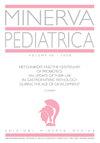The characteristics of self-care in children with spinal muscular atrophy: an integrative review.
IF 2.6
4区 医学
Q2 Medicine
引用次数: 1
Abstract
BACKGROUND Spinal muscular atrophy (SMA) is one of the most common genetic causes of death in children. Recently, European Commission (EU) has approved a new gene therapy based on onasemnogene abeparvovec (Zolgensma) for the treatment of patients with SMA. It is essential that children suffering from SMA also apply self-care methods to maintain their health, monitor their weight and food intake, and use appropriate remedies. Indeed, self-care is a crucial element in the health care system because it is able to improve survival and prevent hospitalizations. The purpose of this review is to systematically explore the characteristics of self- care in children with spinal muscular atrophy and the relationship with their parents and the collaboration of healthcare professionals. METHODS An integrative review of the literature has been conducted. The electronic databases CINAHL, Embase, PubMed, and SCOPUS were searched. RESULTS Thirteen articles met the inclusion criteria and were reviewed using Whittemore and Knalf's integrative review methodology. The analysis of the 13 articles selected for the review show that previous literature has focused on six prevalent themes: problem solving and care behavior, decision making, optimizing living with an illness, high quality, childfocused homecare, healthcare professionals, and monitoring behaviors. CONCLUSIONS This paper highlights how self-management behaviors depend on four basic aspects: the person (individual, cognitive, and social perceptions), the patient's family (level of knowledge of the pathology, involvement in the management and quality of relationship with the patient), the community (relationships with external social contexts, such as school and other organizations), and the healthcare system (availability of resources and the degree of evolution of healthcare).脊髓性肌萎缩症患儿自我护理的特点:一项综合综述。
背景脊髓性肌萎缩(SMA)是儿童死亡最常见的遗传原因之一。最近,欧盟委员会(EU)批准了一种基于onasemnogene abeparvovec(Zolgensma)的新基因疗法,用于治疗SMA患者。患有SMA的儿童也必须采用自我护理方法来保持健康,监测他们的体重和食物摄入,并使用适当的补救措施。事实上,自我护理是医疗保健系统中的一个关键因素,因为它能够提高生存率并防止住院。本综述的目的是系统地探讨脊髓性肌萎缩症儿童的自我护理特点,以及与父母的关系和医疗保健专业人员的合作。方法对文献进行综合评述。检索电子数据库CINAHL、Embase、PubMed和SCOPUS。结果这些文章符合纳入标准,并使用Whittemore和Knalf的综合评审方法进行评审。对入选该综述的13篇文章的分析表明,以前的文献集中在六个普遍的主题上:问题解决和护理行为、决策、优化疾病生活、高质量、以儿童为中心的家庭护理、医疗保健专业人员和监测行为。结论本论文强调了自我管理行为如何取决于四个基本方面:个人(个人、认知和社会认知)、患者的家庭(病理学知识水平、参与管理和与患者关系的质量)、社区(与外部社会环境的关系,如学校和其他组织),以及医疗保健系统(资源的可用性和医疗保健的发展程度)。
本文章由计算机程序翻译,如有差异,请以英文原文为准。
求助全文
约1分钟内获得全文
求助全文
来源期刊

Minerva pediatrica
PEDIATRICS-
CiteScore
2.70
自引率
3.80%
发文量
1
审稿时长
>12 weeks
期刊介绍:
Minerva Pediatrica publishes scientific papers on pediatrics, neonatology, adolescent medicine, child and adolescent psychiatry and pediatric surgery. Manuscripts may be submitted in the form of editorials, original articles, review articles, special articles, letters to the Editor and guidelines. The journal aims to provide its readers with papers of the highest quality and impact through a process of careful peer review and editorial work.
 求助内容:
求助内容: 应助结果提醒方式:
应助结果提醒方式:


